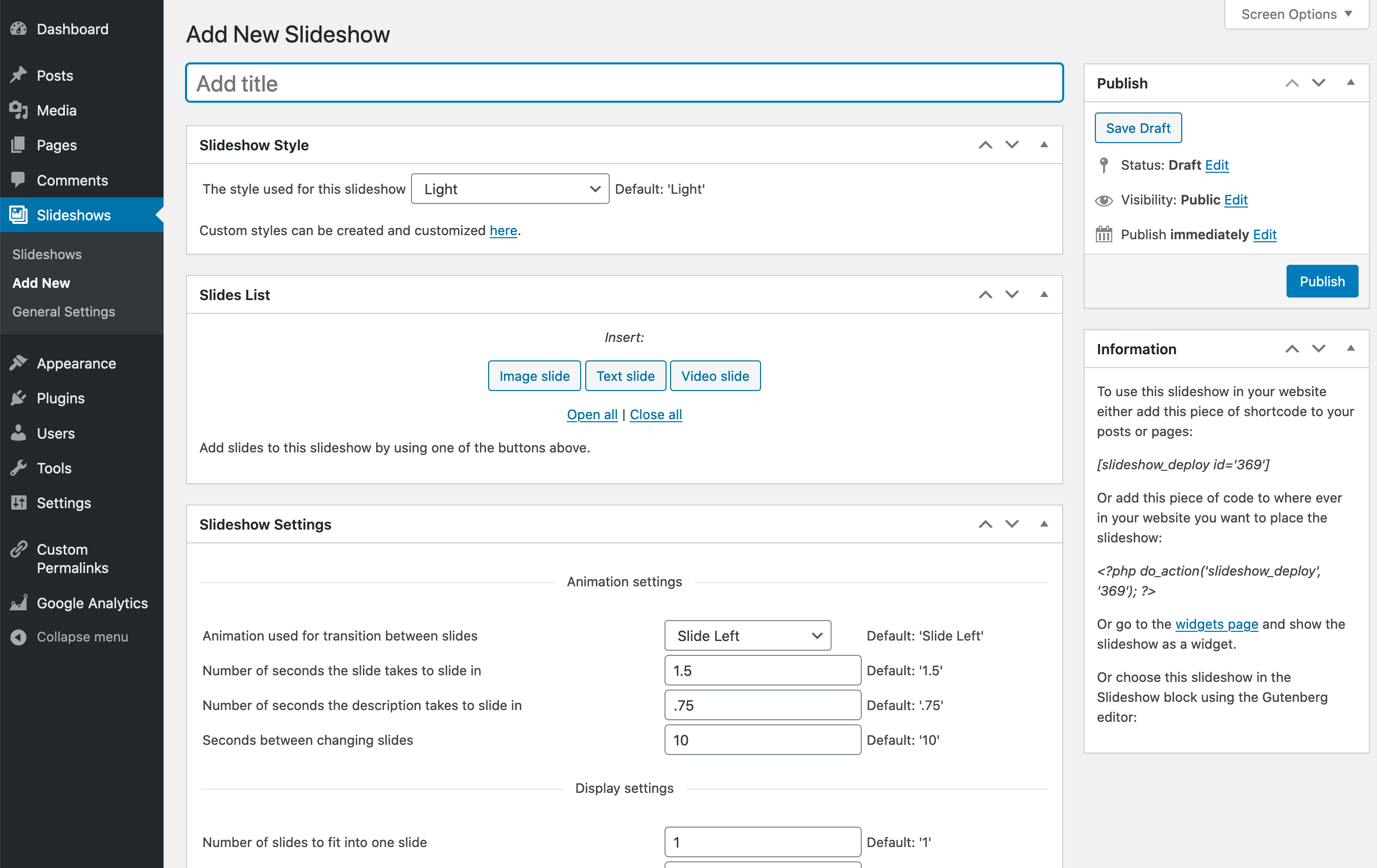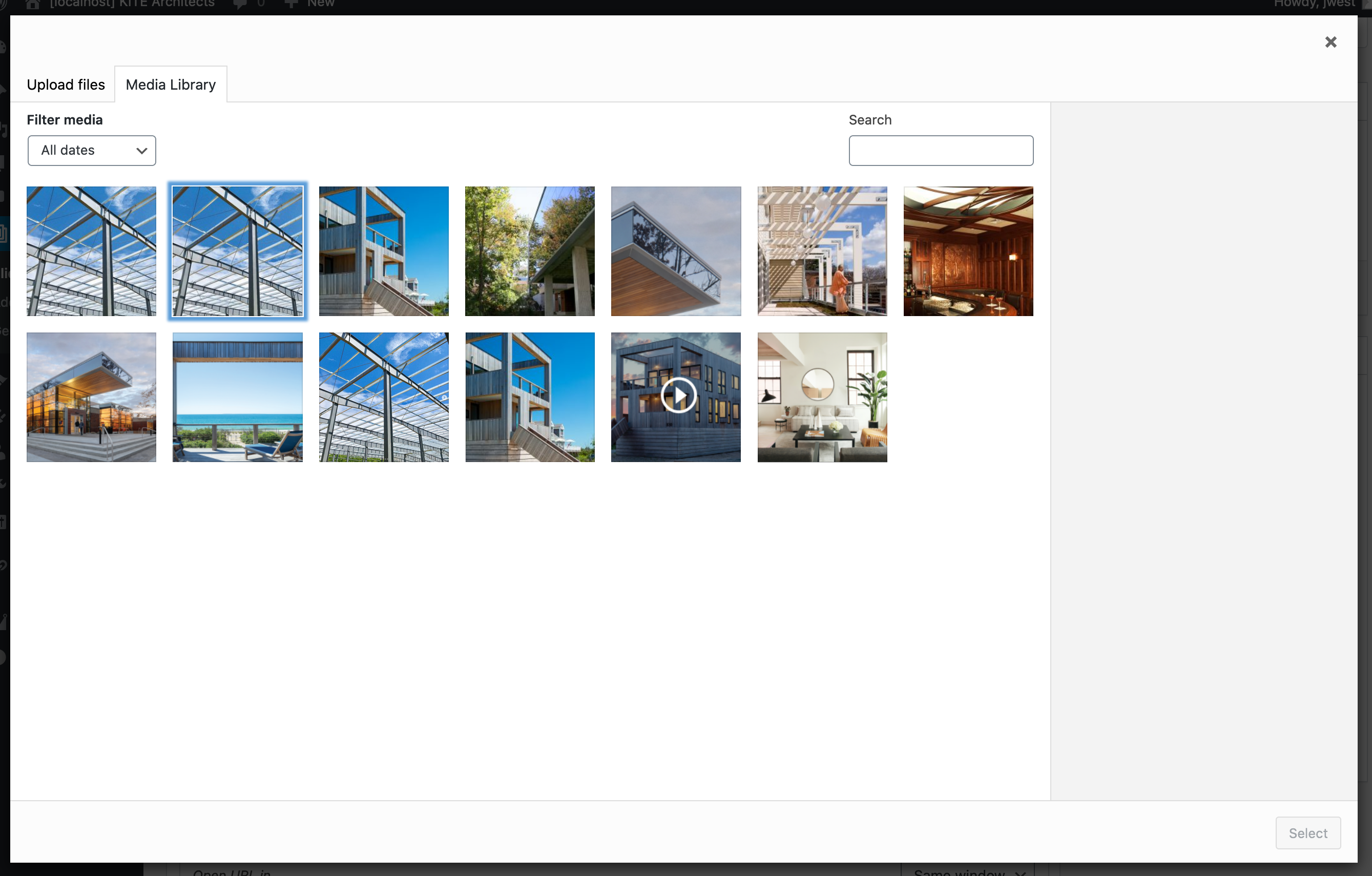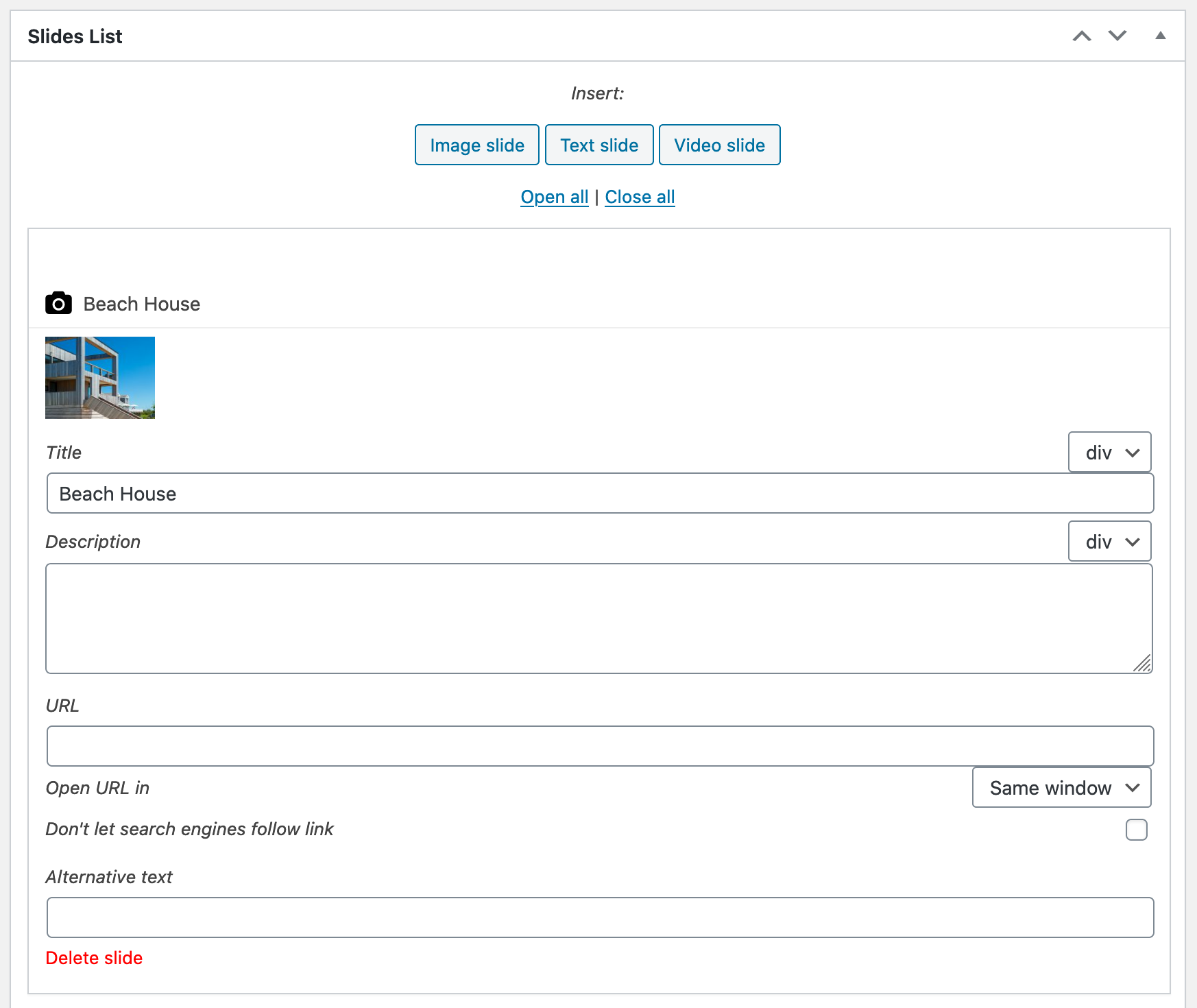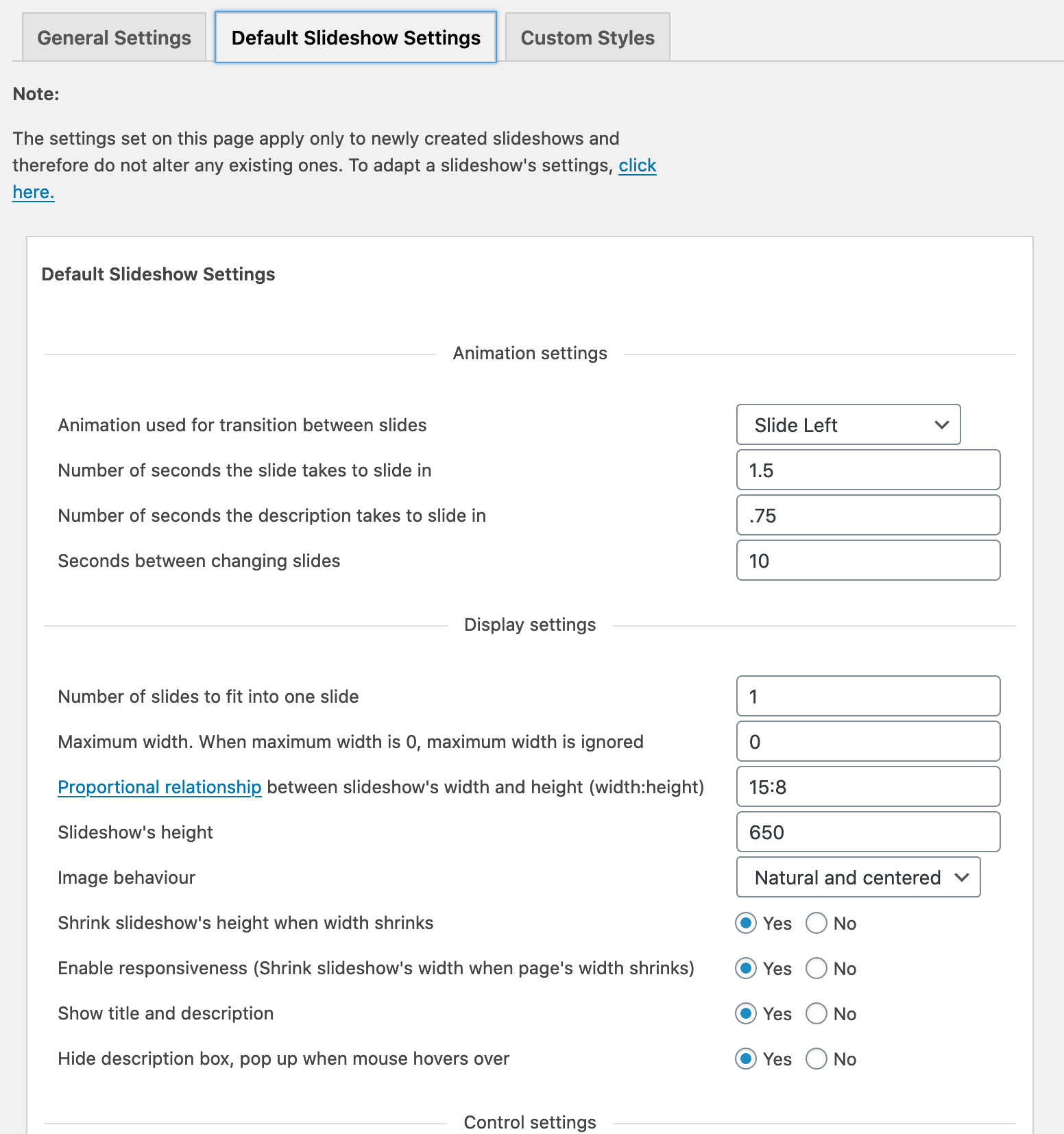
Slideshow SE Plugin
Completely free, open source plugin to easily add slideshows to your WordPress site.
Slideshow SE provides an easy way to add a slideshow to any WordPress installation.
Any image can be loaded into the slideshow by picking it from the WordPress media page, even images you’ve already uploaded can be inserted into your slideshow right away!
Fancy doing something crazy? You can create and use as many slideshows as you’d like, with different images, settings, and styles for each one of them.
Features
- First (rough) stab at a Gutenberg block
- Create as many slideshows with as many slides as you like
- Image slides
- Text slides
- YouTube Video slides
- Responsive
- Place it anywhere on your website
- Run multiple slideshows on the same page
- Change animations and handling
- Customizable stylesheets
- COMPLETELY FREE AND OPEN SOURCE
Need the (uncompressed) source code?
The forked code is available on GitHub.
The original project’s source code is also in a GitHub repository.
Links
Installation
Install Slideshow SE either via the WordPress.org plugin directory or by uploading the files to your server.
After activating Slideshow SE, click on ‘Slideshows’ and create a new slideshow.
Click on ‘Insert Image Slide’ to insert an image slide, a popup will appear where you can search for the desired
image. Insert the image by clicking ‘Insert’. The same goes for text and video slides, don’t forget to save!Add the slideshow to your post.
If you are using the Classic editor, go to a post or a page and click the ‘Insert Slideshow’ button above the editor. A popup appears where you can select your newly created slideshow to insert. You can also use the shortcode or code snippet visible in your slideshow admin panel to deploy your slideshow anywhere on your website. Use the widget to show any of your slideshows in the sidebar of your website.
If you are using Gutenberg, add a new block and search for Slideshow SE or choose Common > Slideshow SE from the blocks list. Choose the slideshow you want to add from the popup menu.
Screenshots

Here's what a default slideshow can look like. This one uses a custom stylesheet.

Create a new slideshow. Slides and settings specific to this slideshow can be set here.

If you haven't uploaded any images yet, you can do so on the WordPress media page.

Click the 'Image Slide' button in the Slides List to search and pick images from the WordPress media page. Click 'Insert' to insert the image as slide.

The images you selected are directly visible in your Slides List, don't forget to save!

When you understand the basics of creating slideshows, you may want to go a little more in depth and have a look at the General Settings page. As seen in the image above, privileges can be granted to user roles to give users the ability to add, edit or delete slideshows.

Default slideshow settings can be edited here. Slideshows that are newly created, will start out with these options.

Custom styles can be added and modified here. Custom styles can be used to style one or more slideshows to your own personal taste.

Choose your slideshow using the Gutenberg block!
FAQ
Click the ‘Image slide’ button in the ‘Slides List’ of the slideshow. A screen will pop up where you’ll be able to search though all images that have already been uploaded to your WordPress website. If you want to add new images to the slideshow, or you do not have any images yet, you’ll have to upload them to the WordPress media page first.
Just like the posts and pages you’re already familiar with, slideshows can be edited. Go to the ‘Slideshows’ tab in your WordPress admin, and you’ll see a list of slideshows. If you have not created a slideshow yet, you can do so by clicking ‘Add new’ on that same page. If there are slideshows in the list, click on the title of the slideshow you want to change the settings of. On the slideshow’s edit page you’ll be able to find a box titled ‘Slideshow Settings’, in this box you can change the slideshow’s settings.
If you’re creating multiple slideshows that should have the same settings, but their settings need to be different from the default settings, you can change the default settings by going to the ‘General Settings’ page and clicking on the ‘Default Slideshow Settings’ tab. Newly created slideshows will start off with the settings you set there.
On your WordPress admin page, go to the ‘Slideshows’ menu item and click on ‘General Settings’, then go to the ‘Custom styles’ tab. Here you’ll see a list of default stylesheets, such as ‘Light’ and ‘Dark’, and a list of custom stylesheets; The ones you created.
Choose a default stylesheet you’d like to customize and click ‘Customize’ to open the ‘Custom style editor’. When you’re done editing click ‘Save Changes’ and go to the slideshow you’d like to style with the newly created stylesheet. In the ‘Slideshow Style’ box you can now find and select your custom stylesheet. You can set a stylesheet for multiple slideshows.
If you’ve already created a custom stylesheet, you can edit it by clicking ‘Edit’. You can also delete it by clicking ‘Delete’. Be careful with this though, a deleted stylesheet cannot be retrieved and cannot be used by any slideshow anymore.
Yes you can. On your WordPress admin page, go to the ‘Slideshows’ menu item and click on ‘General Settings’, then go to the ‘User Capabilities’ tab (If you’re not already there). The privileges that allow user groups to perform certain actions are listed here. To allow, for instance, a contributor to add a slideshow, click the box in front of ‘Contributor’ to grant him the right to add slideshows.
Note that when you grant someone the right to add or delete a slideshow, you’ll also automatically grant him or her the right to edit slideshows, as this right is required to add or delete slideshows. The same is true for the reversed situation.
The slideshow is mostly called after the
</head>tag, which means the scripts and stylesheet need to load in the footer of the website. A theme that has no<?php wp_footer(); ?>call in it’s footer will not be able to load the slideshow’s scripts.Often when the slideshow isn’t showing, there’s a javascript error somewhere on the page and this error has caused javascript to break. For the slideshow to work again, this error needs to be fixed. Check if any errors were thrown by opening Google Chrome or Firefox (with Firebug installed) and press the ‘F12’ key. Errors show in the console tab.
Internet Explorer is a very strict browser, so when a big blank space above your slideshow is showing your page may contain some invalid HTML. Most times invalid HTML is caused by placing the slideshow’s shortcode or PHP snippet into an anchor tag (<a></a>) or paragraph tag (<p></p>), while you can only place a slideshow within a ‘div’ element (<div></div>).
Good question! There are a couple reasons: First, I maintain a site that has hundreds of slideshows and, to be honest, it’s more rewarding for me to update the plugin than it is to find a new one and manually convert all the slideshows to whatever the new one is. Secondly, there is a real dearth of good quality, FREE slideshow plugins for WordPress. I’m not saying this one is the best, but it’s pretty good and more or less honors WordPress UI. There’s nothing worse than installing a new slideshow plugin only to find that your admin interface is now an ungodly color with giant, weird fonts and icons and your slideshows are now being stored in the cloud for a monthly fee. Ugh. So, primarily I’ll be maintaining this fork to suit my needs but I will entertain suggestions or pull requests. I’m (probably) not going to rewrite this plugin, but I will work to keep it functioning in the up-to-date versions of WordPress and I’ll implement new features as I need them (i.e. the Gutenberg block, which I hope to improve).
Well, first up is to improve the Gutenberg block. I want to add a preview so that you can see what your post will look like on the backend. I have some good ideas on that front. Also, I want to beef up the video slide option. Just having YouTube doesn’t cut it. That will probably mean a new slide type and deprecation of the YouTube slide (but I won’t drop support for the current YouTube slides). After all that, I’m thinking about supporting either Bootstrap carousel or Slick carousel in addition to the original version. Or maybe both. I need to do some analysis to see if one is easier or if both are possible.
Absolutely! I will look at all pull requests on the Github repo. If you have any feedback or suggestions or want to volunteer, please post over on Github. While I will monitor the WordPress Support forums, I spent a lot of my day on Github so I’m more likely to see your post over there. Thanks in advance for your help in make this the best slideshow plugin available for WordPress, free or not!
Changelog
2.5.20
- Fix link display issue.
2.5.19
- Fix widget display issue.
- Fix issue where settings aren’t displaying correctly.
2.5.18
- Fix local file injection (LFI) issue.
- Fix various security issues.
2.5.17
- Fix XSS issue in image slides.
2.5.16
- Fix XSS issue in text slides.
2.5.15
- Fix double escaping on text slides in backend.
2.5.14
- Fix double escaping on text slides.
2.5.13
- Fix error with PHP 8
2.5.12
- Remove output of messages to error_log.
- Tested to WordPress 6.3
2.5.11
- Fix display of stylesheet dropdowns.
2.5.10
- Fix widget display.
2.5.9
- Fix double quote bug.
2.5.8
- Fix bug where links are showing up as text.
2.5.7
- Fix crashing bug.
2.5.6
- Fix XSS issue. Thanks to Ngo Van Thien (Patchstack Alliance).
- Update banner image.
2.5.5
- Tested to WordPress 6.0
- Edits to ReadMe
2.5.4
- Update jQuery load() usage
2.5.3
- Fix issue with blank slides
2.5.2
- Update version numbers
2.5.1
- Fixed issue with saving slideshow settings
2.5.0
- Removed “Support this plugin” code and translations.
- Edits to Read Me due to forking the code.
- Minor bugfixes.
- First (limited) version of Gutenberg block.
- Forking the code; rename plugin to Slideshow SE; rename classes, namespace, etc.
2.3.2
- Fixed: Setting the “Stylesheet location” setting to “Footer” no longer causes HTML5 validations errors.
- Fixed: Setting the “Stylesheet location” setting to “Head” did not prevent the stylesheet from showing up in the footer.
- Fixed: Element tags could not be set on text slides.
2.3.1
- Fixed: Text and video slides could not be inserted.
2.3.0
- Refactored the slideshow plugin’s backend codebase to prepare for a larger backend rewrite.
- Removed backwards compatibility on inserting images with pre-3.5 versions of WordPress.
- Slideshows now work on infinite scroll and single page websites through the “Enable lazy loading” option.
- Fixed: YouTube thumbnail image disappeared after clicking the slideshow’s navigation buttons.
2.2.25
- Changed localization domain to match the plugin’s slug in order to support language packs.
2.2.24
- Compatible with WordPress 4.3.
- Widget constructor no longer uses deprecated PHP 4 style constructor.
- Fixed: Mismatch between session ID and settings ID.
- Fixed: Unescaped data in slideshow editor.
- Fixed: Resizing issues.
- Added Ukrainian translation and updated Russian translation, thanks to Coupofy.
2.2.23
- Fixed: Despite default stylesheets now loading through static file again, admin-ajax.php was still being called.
- Fixed: Invalid HTML in the shortcode inserter. Thanks to Iazel.
- Fixed: HTML5 validation issue when loading stylesheets in the head of the document.
- Fixed: Slideshows now load their settings by slideshow ID, instead of the variable session ID.
- Updated Spanish translation, thanks to Manuel Ballesta Ruiz.
2.2.22
- Compatible with WordPress 4.2.
- Default stylesheets are no longer dynamically loaded through admin-ajax.php.
- Fixed: Security vulnerability in the SlideshowPluginSlideshowStylesheet class.
- Fixed: An issue with admin-ajax.php when the frontend uses HTTP, while the backend uses HTTPS. Thanks to Chris Scott
- Fixed: A bug that caused the previous slide button and the navigation bullets to malfunction on “Cross Fade” setting.
- Fixed: Slideshow container calculation now uses the JavaScript round function instead of the floor function.
- Fixed: Separated assignment of $sessionID and increment of SlideshowPlugin::$sessionCounter.
- Added Norwegian translation by A. Nonymous.
- Updated Persian translation by W3Design.
- Updated German translation by A. Nonymous.
- Updated Brazilian Portuguese by A. Nonymous.
2.2.21
- Compatible with WordPress 3.9.
- Added “Cross Fade” option to the animation settings.
- Updated the API to support retrieving the direction of the animation on the animation event.
- Fixed: Slideshow moving to next slide on keyboard navigation. By Ben Wetzel
- Fixed: HTML5 validation issue.
- Fixed: Permission check that checked for “edit_post” instead of “edit_slideshow”.
2.2.20
- Compatible with WordPress 3.8.
- Accessibility improvements by Ben Wetzel
- Title and description element types can now be set from backend and anchor tags are omitted when no URL is set.
- Improved functional stylesheet.
- Post published/updated message doesn’t show a link to a non-existant page anymore.
- New tags are available for custom stylesheets: %site-url%, %stylesheet-url% and %template-url%
- Fixed: When the slideshow would not have any height, slides would not hide outside of the slideshow.
- Added Serbo-Croatian translation by Webhosting Hub.
- Updated Persian translation by W3Design.
- Updated Chinese translation by Leo Newbiesup.
- Updated Swedish translation by Wilhelm Svenselius.
2.2.19
- Slideshows can now detect when their stylesheet isn’t loaded and load their own when this is the case.
- The functional stylesheet should now provide a more stable base for all slideshows.
- Fixed: Uploading images through the WordPress 3.5 uploader on a slideshow’s edit page would return an error.
- Fixed: Images with a ‘max-width: 100%;’ style rule would size wrongly on responsive websites.
- Fixed: The randomization method returned error messages.
2.2.18
- Added option to select whether or not search engines should follow a slide’s link.
- Improved filter avoiding mechanism.
- Disappearing settings now have a more apparent animation.
- Fixed: First slide of a slideshow wouldn’t show when the slideshow’s content had no size on page load.
- Added Brazilian Portuguese translation by Piero Luiz.
- Updated French translation by Romain Sandri.
2.2.17
- Fixed: Images disappeared when their width was larger than the slide’s width and image behaviour was set to ‘Natural and centered’
2.2.16
- Inserting images can now be done using the WordPress 3.5 uploader.
- Images can now fill up an entire slide without losing their dimensions, using the ‘Zoom to fit’ option.
- Fixed: Descriptions came up and stayed up on fly-over.
- Fixed: Image calculations failed in a few because of a ‘jQuery.outerWidth()’ bug.
- Fixed: Control panel wasn’t correctly initialized when slideshow was set to automatically slide to the next slide.
2.2.15
- The image dimension calculation algorithm now uses a more stable and more efficient way to determine the size of images.
- Added slideshow API.
- Fixed: WP Color Picker (Iris) adds a hashtag to color codes. As slideshow does this as well, text slides didn’t display color properly.
2.2.14
- Fixed: Slideshow didn’t show because of a JavaScript error when calculating an unstretched image’s dimension.
2.2.13
- The SlideshowPluginAjax.php has been re-added to SVN.
2.2.12
- Compatible with WordPress 3.6.
- Complete javascript revision to be better manageable with the help of the Prepros tool.
- Related videos can now be enabled or disabled on YouTube videos.
- YouTube API now is only loaded when a video slide needs to be shown.
- Re-arranged the ‘General Settings’ page to have a ‘General Settings’ tab that contains overall system settings.
- Added option to choose the loading location of the stylesheets, as IE8 and older don’t always allow in-body styling.
- Implemented a new algorithm for randomizing slides.
- Slideshow can now wait for a slide to load before showing it.
- Fixed: The ‘Enable responsiveness’ setting disappeared when disabling the ‘Show title and description’ option.
- Added Turkish translation by İlker Akdoğan.
- Added Polish translation by Wicher Wiater.
- Added Finnish translation by an anonymous supporter.
- Updated French translation by Romain Sandri.
- Added Portuguese translation by Filipe Catraia.
- Added Persian translation by W3Design.
- Added Italian translation by Tecnikgeek.
- Added Japanese translation by Michihide Hotta.
2.2.11
- Fixed: The slideshow script loaded the YouTube API twice.
- Fixed: Floating the slideshow resulted in it having no width, therefore being invisible.
- Fixed: Sites that don’t support URL data weren’t able to load a slideshow’s stylesheet correctly.
- Fixed: Slideshow randomly disappeared in Internet Explorer 8 when absolute positioning was used.
- Added Swedish translation by Åke Isacsson.
- Added Hebrew translation by Eli Segev.
2.2.10
- Fixed: Auto margin combined with a fixed width will no longer break slideshow’s responsiveness.
- Updated Russian translation, thanks to Dmitry Fatakov.
2.2.9
- Fixed: Descriptions didn’t show when ‘Hide descriptions’ was set to ‘No’.
- Fixed: Title was given wrong size by CSS.
2.2.8
- Fixed: Images that have a, to WordPress, unknown size weren’t able to show on all websites.
- Fixed: Images in the image inserter popup were being skipped over when loading more results because of a faulty query.
- All stylesheets are now loaded at the page’s bottom to validate in HTML checkers and be cached by the visitor’s browser.
- Improved the handling of description boxes. Description boxes will no longer be ‘jumpy’ nor will they pop up on fly-over.
- Errors in jQuery’s ‘ready’ method no longer stop the slideshow from showing. However, JavaScript errors should always be resolved.
- Text slides can now have transparent backgrounds by leaving the ‘Background color’ field empty.
2.2.7
- Fixed: Slideshow control buttons were placed behind the slideshow.
- Fixed: Image slides doubly inserted after having clicked on ‘Load more results’
- Included width and height attributes on all image elements.
2.2.6
- Fixed: Theme’s that set image heights affected the slideshow’s image dimensions.
- Fixed: Compatibility with the ALO EasyMail Newsletter plugin.
- Fixed: Image’s ‘alt’ values didn’t show when no image title was set.
2.2.5
- Fixed: Slideshow settings nonce prevented 3.4 and older WP users from saving their slideshows.
2.2.4
- Fixed: Video slideshows will now work on mobile devices supported by YouTube.
- Fixed: Removed multi-line element tags to prevent WordPress from adding ‘
‘ tags into them. - Fixed: Quick editing a slideshow deleted its content.
- Image files can now be found by their file names.
2.2.3
- Fixed: A ‘console.log();’ message presumably caused Internet Explorer to have problems when inserting slides.
- Fixed: Slideshows that are hidden on page’s load now wait to become visible before calculating their size.
2.2.2
- Fixed: Float and size bugs caused by the maximum width element.
- Fixed: PHP errors were showing in ‘Delete slide’ links.
- Live width calculations have been halved to improve performance.
- Default settings have been tuned to cater better to most users.
- Added Czech translation by Edhel.
2.2.1
- Fixed: A bug in the width calculations caused slideshows in width-less elements to be hidden.
- Fixed: The functional stylesheet defined the last five header elements for the entire page, instead of just for the slideshow.
- Fixed: Pagination bullets were showing multiple times because of a CSS bug.
- Padding and margin in unordered lists set to 0 by default.
- Videos can now be played in full-screen.
- Functional stylesheet temporarily moved to the head section of the page until the stylesheets can be loaded beneath it.
2.2.0
- The slideshow script has been completely renewed, making it more lightweight, more versatile and responsive altogether.
- Slideshow now has a continuing loop.
- Pagination bullets can now be shown.
- Slide order can now be completely random, as can the animation type.
- Added new animations.
- Slideshow now pauses when a (YouTube) video is playing or when a mouse is hovering over.
- Fixed: Image title and description were wrongly filled with attachment’s content.
2.1.23
- Default settings can now be changed from the ‘General Settings’ page.
- Custom styles are now shared across all slideshows and endless customizations can be created.
- Added input fields to set separate titles and descriptions for shared images.
- Cleaned up the slides list’s layout, to reach a more WordPress-like look.
- Adapted the ‘Dark’ style to be more compatible with the WordPress TwentyTwelve theme.
- Changed ‘Insert Slideshow’ link to appear as a button.
- Empty settings won’t be shown at the end of the settings boxes.
2.1.22
- Added French translation.
- Added a “General Settings” page, containing user capability settings.
- Cleaned up unnecessary settings that were showing on page.
- Replaced the, in WordPress 3.5, deprecated function ‘wp_get_single_post’ with the ‘get_post’ function.
- Added an on-page error logger to be able to solve back-end issues faster. Nothing is shown when no errors exist, doesn’t affect SEO.
2.1.21
- Fixed: Adding new slides was made impossible by a faulty setting.
- Fixed: Image tag placed on multiple lines caused some sites to not display images correctly due to an inserted break character.
2.1.20
- Fixed: Query filters will no longer alter the output of the slideshow.
- Fixed: Images not always showing in image inserter popup.
- Compatibility with WordPress 3.5 confirmed.
- First back-end increment towards version 2.2.0, introducing a more efficient way to store and retrieve the slideshow’s settings and slides.
2.1.19
- Fixed: Slides are now always floated, despite any parent CSS settings.
- Fixed: Slideshow settings will no longer cloud any other posts with their post-meta.
- PHP snippet will now only be shown when the current user can edit themes.
- Videos in the slideshow will from now on depend on WordPress’ swfobject.js file.
- Changed slideshow’s script namespace from ‘slideshow_script’ to ‘slideshow-jquery-image-gallery-script’.
- Untitled slideshows in the widget form will now display as ‘Untitled slideshow’, instead of an empty field.
2.1.18
- Text slide descriptions are now displayed in text areas, making editing of long descriptions more convenient.
- Backgrounds of text slides can now be set to transparent by leaving the ‘Background color’ field empty.
- Settings are now loaded from a JavaScript variable, so (the major) search engines won’t read them as actual content.
- Widget title’s HTML tags are now discarded when no widget title is set.
2.1.17
- Fixed: Invalid argument being supplied for the foreach loop in SlideshowPluginPostType on line 352.
- Fixed: Undefined index being thrown by URL target setting on slideshow creation.
- Video slide now accepts YouTube URLs as well.
2.1.16
- Security update enabling HTML in slides again, but only allowing it in a very strict format without any scripts.
- Added shortcode editor, which provides a more convenient way of inserting slideshows in your posts and pages.
- Updated the way slideshows are retrieved. A faulty ID will no longer cause the slideshow to not show at all.
- Slideshows can now also be fetched by their slugs.
- The example shortcode’s ID on the slideshow settings page is now surrounded by quotes to prevent confusion.
2.1.15
- Fixed: Security issues.
- Added Chinese translation.
2.1.14
- Fixed: Text slide descriptions allow HTML again.
2.1.13
- Fixed: PHP security issues.
- Set order of images gotten in ‘Image slide’ pop-up to post date, descending.
2.1.12
- Moved slideshow activation to the footer script. Footer jQuery scripts are now supported.
2.1.11
- Fixed: Conflict with the Gravity Forms plugin.
2.1.10
- Fixed: Slideshow widget form now is compatible with older versions of PHP, that didn’t recognize a null value as a set value.
2.1.9
- Fixed: Not all admin themes support scripts in the admin footer, admin scripts are moved to the header.
2.1.8
- Option added to be able to control whether to use a filter, or to directly output on shortcode.
2.1.7
- Fixed: Slideshow in some cases unable to show next slide in fade animation.
2.1.6
- Slideshow widgets are loaded using theme sidebar settings, making the widget more dynamic.
- Fixed: Slideshow widget title can now be set to an empty value.
2.1.5
- Fixed: WordPress intervened with the HTML output by the shortcode, this caused scripts to break.
- Fixed: Slideshow width isn’t affected by width-less elements anymore, instead it seeks the first div’s width.
2.1.4
- Fixed: Slideshows in posts are now longer broken by WordPress inserted ’em’ tags.
- Fixed: Image borders no longer fall off-slide.
2.1.3
- Fixed: Overflow container now adapts to its parent element correctly.
- Fixed: Internet Explorer now shows control panel (buttons etc.) on top of the Flash element.
- Fixed: Images are now loaded by the WordPress function, rather than being loaded from the database’s ‘guid’.
2.1.2
- WordPress media uploader link in image inserter pop-up now opens in a new window.
- Fixed: Image inserter pop-up CSS no longer pushes the ‘insert’ buttons off-screen.
2.1.1
- Fixed: Settings meta-box threw an unexpected ‘T_ENDFOREACH’ since a shorthand PHP tag was used improperly.
2.1.0
- Added Youtube video slides.
- Slide URLs can now be chosen to open in a new window.
- Added headers above settings, giving the user mover oversight.
- Endless scrolling is now available in the image inserter pop up.
- Images are now centered in their slides by default.
- Script is now activated on document ready, not window load.
- Hid slides in another element so that buttons could overflow the slideshow container.
- Fixed: Hide-away settings were influenced by their own settings fields.
- Fixed: Stretching was not always handled correctly.
- Fixed: Script counter made the first view show twice.
2.0.1
- Fixed: Version 1.x.x slides disappeared after updating to version 2.0.0. An automatic converter has been added.
2.0.0
- Complete sideshow script revision to support new features.
- The script now supports two kinds of animations: ‘Slide’ and ‘Fade’.
- Multiple images can be shown in one slide, instead of one.
- Text slides are available.
- Descriptions are more cooperative, they don’t overlap the entire image anymore. (Instead they hide or have a user-defined fixed height)
- Multiple slideshows can now be shown on one page.
- Play and pause buttons are now available, as is the option not to auto-play and/or loop the slideshow.
- Stylesheets no longer partially depend on the website’s stylesheet, except for the fonts.
- The script and its functional stylesheet are now compressed to save loading time.
- Added jQuery sortables script to sort slides.
- Images you’ve already uploaded and attached to other posts can now be loaded into the slideshow, saving disk space (and time).
1.3.5
- Fixed: Namespace complications found with the Slideshow widget, renamed all classes.
1.3.4
- Fixed: Custom width of the slideshow will no longer cause buttons to fall off-screeen.
1.3.3
- Extended compatibility to servers that do not support short php opening tags.
1.3.2
- Fixed: 1.3.1 Bugfix failed to work, fixed problem entirely after reproducing it.
- Added alternative way to load default css into empty custom-style box, so that users without ‘allow_url_fopen’ enabled aren’t influenced negatively by it.
1.3.1
- Fixed: Check if function ‘file_get_contents’ exists before calling it, some servers have this disabled. (This throws errors and messes up the plugin)
1.3.0
- Added Dutch translation.
- Custom styles for each slideshow are now available to be more compatable with every theme. (Black and transparent scheme)
- Encapsulated a css class so that it does not interfere with anything outside the slideshow_container.
- Moved slides list to the side, saving space on the slideshow specific settings page.
- Settings bugs completely fixed, finally. (Previous version deleted post-meta on auto-save)
- Moved Slideshow settings and images script to inside the slideshow_container, outputting a more coherent whole.
- Settings moved from multiple meta keys to a single one. (This resets everyone’s settings)
- Added a WordPress media upload button to the slides list, this simplifies attaching images to a slideshow.
- Better way of including the jQuery library is now being used.
- Fixed bug with the number of slides shown in the slideshow stuck at the default value of five.
1.2.1
- Fixed: Slideshow specific settings not saving.
1.2.0
- Slideshows can now be placed in posts as well, using shortcode [slideshow id=SlideshowPostId].
- Added a widget that can be loaded with an existing slideshow of choice.
- Tested up to version 3.4.
1.1.0
- Added jQuery library as WordPress websites don’t seem to load them by default.
- Slideshow script now depends on by the plugin enqueued jQuery script.
1.0.1
- Added documentary comments.
- Fixed error with directory paths causing Slideshows post type page to generate warnings.
1.0.0
- Initial release.